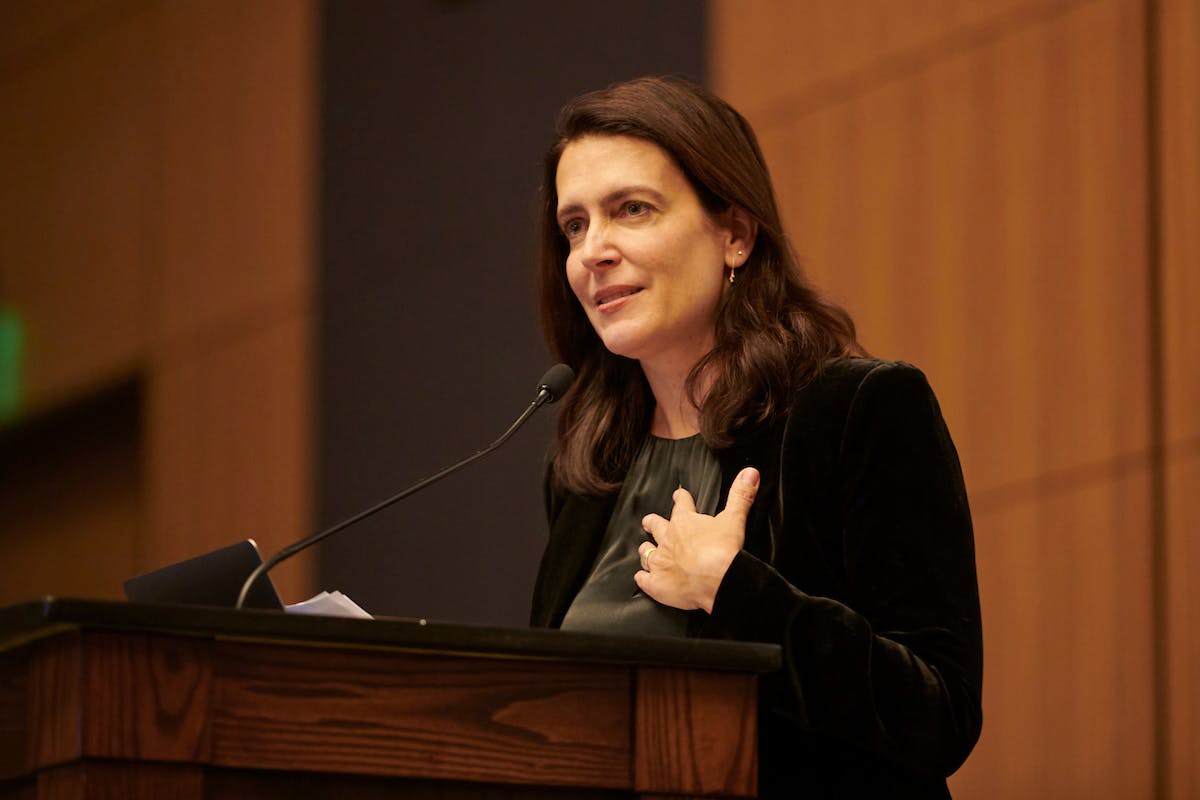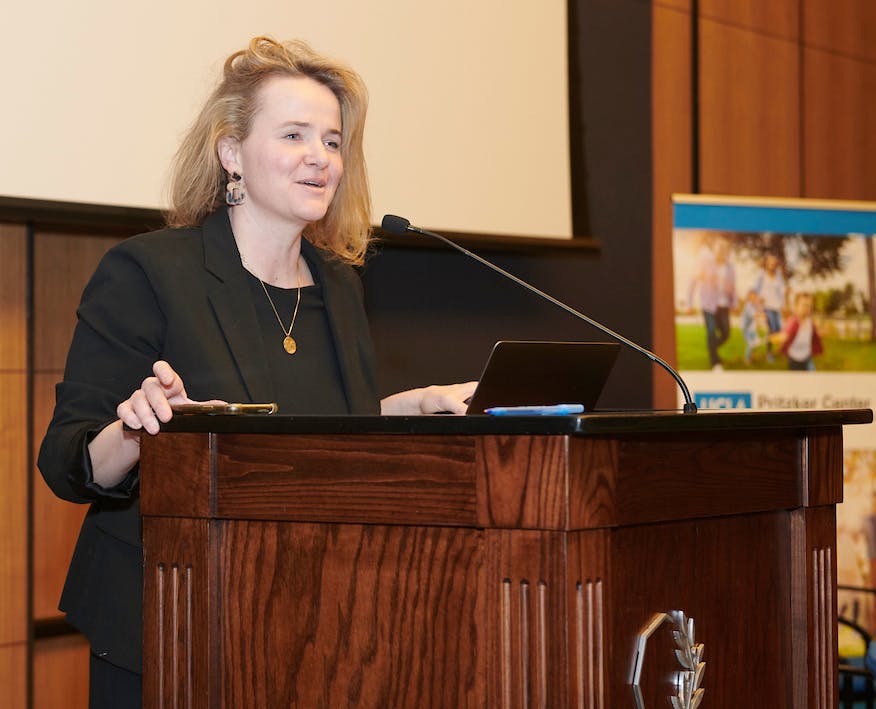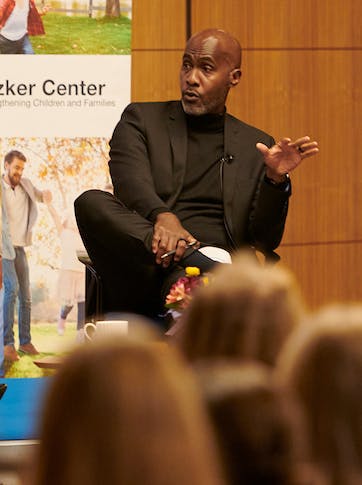UCLA Pritzker Center for Strengthening Children and Families Hosts Author of “Invisible Child”
Andrea Elliott shares perspective on her Pulitzer Prize-winning book.
“Invisible Child: Poverty, Survival and Hope in an American City,” by journalist Andrea Elliott, tells the story of a bright, talented, and resilient girl by the name of Dasani, as she grows toward adulthood, poor and Black in New York City.
But it is more than that. As Elliott writes in the early pages of the book, “…to know Dasani Joanie-Lashawn Coates – to follow this child’s life from her first breaths in a Brooklyn hospital to the bloom of adulthood – is to reckon with the story of New York City, and, beyond its borders, with America itself.”
In doing so, Elliott trains a keen eye not only on the lives of Dasani and her family, but on issues of poverty and race, and on the disparate agencies and policies established to help children and families, which too often, fail to do so.
Elliott came to UCLA on January 23 to discuss her Pulitzer Prize-winning book and the issues and implications that it raises for the nation and communities, and for programs and policies intended to help children and families.

Journalist Andrea Elliott discussed "Invisible Child," and the ways in which poverty and ineffectual - and often, generously funded - agencies fail to serve poor children and families.
In writing the book, Elliott said, “I have come to question every assumption people make about the poor.”
Hosted by the UCLA Pritzker Center for Strengthening Children and Families, the event gathered more than 150 academic researchers, advocates and those working in agencies and community organizations that serve low-income children and families in the Los Angeles area, to hear the story of Dasani and the lessons Elliott gleaned in its telling.
“Race and poverty intersect with foster care and education every day and in every moment of too many children’s lives. For individuals working directly with children and families, the urgency of change is apparent—it is often right in front of you. ‘Invisible Child’ reminds us of the real people in critical need of change, and of the systemic hurdles they face in their daily lives,” said Taylor Dudley, executive director of the UCLA Pritzker Center for Strengthening Children and Families. “Our center strives to bring the campus and community together around reducing the need for foster care and reforming the system as it exists today, and the discussion of Andrea Elliott’s tremendously important book provided the perfect platform toward achieving these goals.”

Taylor Dudley, executive director of the UCLA Pritzker Center for Strengthening Children and Families
Elliott’s story about Dasani begins with poverty. She points out that more than 13 million children are growing up poor in the world’s richest superpower – a country with the highest child poverty rate of any wealthy nation -- and asks what that means for our future when poor children complete less schooling, are twice as likely to be incarcerated, to have children as single parents, and to suffer from health problems such as diabetes and asthma.
“Our public discourse on the poor is usually about the adults, not the children, and more specifically about the poor choices those adults have made,” Elliott said. “They are blamed for their conditions of their poverty, for their housing insecurity, for their inability to rise to the promise of America. Maybe it's easier to take that position than to reckon with the barriers that define this population, things like segregated schools, polluted neighborhoods, inadequate health care, chronic food insecurity, little access to jobs that can pay a living wage… instead, it’s the adults that society blames for lacking self-reliance, or personal responsibility.”
But what about their kids? Elliott asked.
“You can't really argue that millions of American children are responsible for their own well-being, or for their own futures,” she said. “You can't argue that their poverty is a result of their own poor choices.”
And so, in reporting for the book, Elliott focused on the children, and in particular, on children like Dasani who grow up experiencing homelessness. Last year, more than 104,000 children in New York City were homeless, a fact Elliott underscored by showing a slide of the Rose Bowl in Pasadena, noting that the homeless children of New York City would overflow its capacity. (Something to consider: “Students Experiencing Homelessness,” a research publication of the UCLA Center for the Transformation of Schools, reports that more than 269,000 children in California experienced homelessness in 2018-19, enough to fill Dodger Stadium more than five times.)
When Elliott met Dasani in 2012, the girl and her family were living in a homeless shelter in Brooklyn near Bedford–Stuyvesant, an area known commonly as Bed-Stuy - a place Elliott describes as, “one of the most unequal neighborhoods in New York City… where townhouses were being renovated and flipped for millions of dollars … just blocks away the decrepit homeless shelter where Dasani lived.” All ten members of Dasani’s family lived there, in a cramped, 500-square-foot room overrun with mold and roaches and mice, in a shelter run by a city agency with what is currently a budget of more than one billion dollars.
“Dasani was homeless because she was poor. But why was she poor?” Elliot asked. “The material reality of Dasani’s life, her lack of money, was really the point of departure for understanding her human condition. It was virtually impossible to separate Dasani’s poverty from everything else. It was the air that her family breathed that informed all parts of their life, housing, education, health, employment and parenting.
“And most especially for this family, there was no separating poverty from race from the daily assault of systemic and societal racism. The story of systemic racism and racial segregation in Brooklyn was pivotal to what happened to Dasani’s family,” Elliot said.

Tyrone Howard, UCLA professor of education and director of the UCLA Pritzker Center for Strengthening Children and Families
Elliot’s remarks were followed by a panel discussion, moderated by author Leslie Gilbert-Lurie, a UCLA Law School graduate and member of the UCLA Foundation Board of Directors , with Demontea Thompson, UCLA SEIS doctoral student, Tyrone Howard, UCLA professor of education, and Christina Christie, Wasserman Dean of the UCLA School of Education and Information Studies.
“What was so critical about what's displayed in this book is the impact of the historical generational racism and poverty and how it impacts the child who's sitting in front of you today,” said Dean Christie. “And you can't disentangle that from that child's lived experience. I think about the importance of the teacher. The children [in the book] absolutely found quiet with their teachers, not in their classrooms, but with their teachers. What does that mean for us as a school of education and information studies, who engages in the very important work of cultivating a sense of humanity and humility in our pre-service and in-service teachers?”
Professor Howard, who in addition to being the director of the UCLA Pritzker Center for Strengthening Children and Families, leads the Black Male Institute at UCLA, said he had a range of emotions about the book, but his main emotion was anger.
“How we can say we value children, but let the circumstances like this persist in the way that they persist? Because for me, probably like for many folks in this room, as you read the stories of pain in this book, many of them were not surprising,” Howard said. “No families, no children should live in circumstances much like this. And the sad part is that it has become so normalized in ways that we accept in a country's political system.
“And I really appreciate that it’s not just a poverty story. It's also a racial story. It's a Black story. It shows the way that systems and structures have had a detrimental impact on Black people.”
Thompson, who experienced foster care as a youth, said he was inspired by the book.
“It reminded me of a lot about my history, about my family's history of coming from Arkansas, having ten siblings, standing in free food lines - these are things that was really described in the book. For me, that just took me back. And it inspired me to actually say, I need to tell the stories of these young people who are in the schools who oftentimes aren't visible.”
“I think L.A. County overall must lead to provide opportunities for young people to speak about their experiences, and then be able to correct some of the things that are happening,” added Thompson. “One example is personal example. My parents were never given the type of support that they needed for us to return back into their care. They too, struggled with drugs and alcohol abuse, and they were never provided the steps and the tools that they needed to succeed. And I think that when you're a Black family, oftentimes its seeing that you made those mistakes yourself, you get yourself out of those, you pull yourself up by your bootstraps. But what do you do when you don't have any boots? Who do you look to when in the community around you, they're not even offering any boots? When you don’t know what boots are?”
Parts of the conversation focused on the potential impact of the book and its implications for those working in systems that serve children and families, not only in New York, but in the Los Angeles area.
“We put a lot on our teachers,” said Christie. “What is critical though is not to ask teachers to also be social workers, but to coordinate care for children and families, so that a teacher has a social worker right next to her when there is a child in crisis. We need to ask how we can we shift the focus away from the family onto the child, to move from intervention to prevention. There are so many more children we don't see that teachers do see, and we need to help teachers by providing them with that system of support. Our community school effort is one way of thinking about how to do that.”
“Schools offer a tremendous opportunity, but they can't do it alone,” concluded Howard. “We have to begin to help teachers, who are already overworked and already stretched beyond belief, to not put more under pressure on those teachers, but to give them support so they can be better support to the children. Because if we lose those beacons of shining light, those teachers in classrooms, we create even more disfavor [for children] and greater hopelessness in our schools. We need greater supports in schools or teachers to support students.”
All photos by Don Liebig/ASUCLA